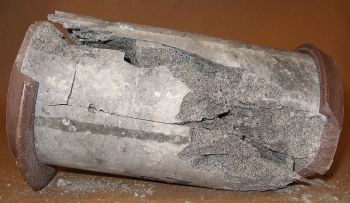Material Properties

|
| Failed Concrete Cylinder.
(Image Source: Wikipedia) |
As a result of the large costs associated with constructing and maintaining a dam, dams often have long design lives upwards of 100 years (the average age of dams in the United States is 60 years old).[1] Additionally, many components of a dam are completely inundated for a large portion of their design lives and are often difficult or even impossible to inspect and/or replace while the dam is in operation. As a result, the materials used to construct the dam must be able to maintain their strength and resist degradation through weathering and corrosion. Additionally, the high risks associated with a failure of many high-hazard potential dams result in the need for thorough testing, analysis, and quality control of both production and installation of the proposed materials, which are all essential to the safety and longevity of the dam as a whole structure. Materials used in the construction of dams include "earth, rock, tailings from mining or milling, concrete, masonry, steel, timber, miscellaneous materials (such as plastic or rubber) and any combination of these materials."[2]
"A proper stability analysis cannot be performed without knowing the potential planes of weakness beneath the structure, the strength of the materials along potential planes of weakness, uplift forces that occur on the structure or on planes of weakness, the strength of backfill materials, and all loads and load conditions to which the structure may be subjected. Knowledge of geologic formation beneath the structure is also important in defining seepage conditions and uplift pressures. Without adequate foundation explorations and testing, the safety factors provided to assess stability of the structure are meaningless. Preliminary stability analyses are useful to identify design parameters, which require special attention. In some rock foundations there may be many faults, shear zones, and discontinuities that make it impossible to do little more than predict average shear and cohesive strengths of the materials that make up the foundation. Use of lower bound values for foundation shear strength or upper bound values for loads is only acceptable when it can be demonstrated that the added costs to improve the accuracy of the strength and loading data will not lead to significant savings for the structure or foundation."[3]
Trainings
![]() On-Demand Webinar: Dam Construction Quality Control: Dos, Dont's and Lessons Learned
On-Demand Webinar: Dam Construction Quality Control: Dos, Dont's and Lessons Learned
![]() On-Demand Webinar: Quality Assurance and Field Inspection for Dam Construction Projects
On-Demand Webinar: Quality Assurance and Field Inspection for Dam Construction Projects
![]() On-Demand Webinar: Pitfalls in Quality Control Processes for Compacted Earth Fill
On-Demand Webinar: Pitfalls in Quality Control Processes for Compacted Earth Fill
Citations:
- ↑ National Inventory of Dams (USACE), 2022
- ↑ ASDSO, 2022
- ↑ Stability Analysis of Concrete Structures (EM 1110-2-2100), USACE, 2005
Revision ID: 7375
Revision Date: 07/21/2023
